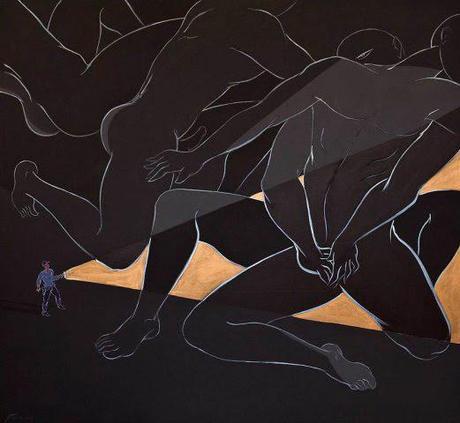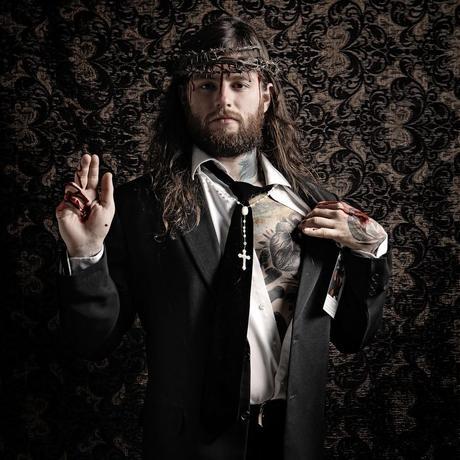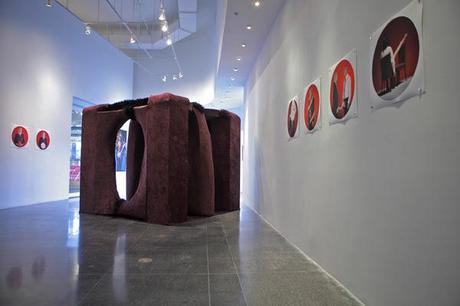ArtCenter’s exhibition, In His Own Likeness, showcased works in diverse media of four Latin American artists who illuminate the subject matter of gender and its relationship with power and divinity. The artists in the exhibition In His Own Likeness are from Guatemala, Mexico and Cuba and include ArtCenter/South Florida resident artist Othón Castañeda, plus visiting artist Eny Roland, with Rocío García and Mario Santizo.
The exhibition was view in March 2014 at ArtCenter’s Richard Shack Gallery.
To curate this exhibition, ArtCenter invited Marivi Véliz, an art historian specializing in Central and Latin American Art. This is her first exhibition in the United States. Véliz is originally from Santa Clara, Cuba with experience curating and lecturing throughout Guatemala, Nicaragua, Brazil, El Salvador and Honduras. In recent years, her focus has been gender studies.
Here is a an email interview with her.
Vidisha: Quoting you [Marivi, from the press release] “The exhibition aims to reaffirm existence as equally divine through its diversity and its complexities. The images of eroticized men allude to the tradition of defining God as masculine and thereby associating power to the male gender.
This in turn addresses how masculinity can unfold, how it can express itself, and even lose all meaning through sex.”
What do you mean by “masculinity can lose all meaning through sex?”
Marivi Véliz: That, in the practice of sex, the constructs of gender vanish. The relationship of every person with his/her sexuality is a mystery, and a mystery where the straitjackets of gender have no place—not even the ever-present straitjackets of masculinity.

Rocío García (Cuba), from her series Very Very Light … and Very Oscuro: Un Policia con Alzheimer, 2009
VF: What do you consider is defining these “hetero norm rules of gender roles”? And if you could give some examples of what they are?
MV: To begin with, the idea of the masculine is automatically associated with men and that of the feminine with women, as if those ideas could not coexist peacefully in the same body. Moreover, although it would seem that women have conquered a lot of space in social institutions and the public sphere in general, that does not mean that they are free of the burden of domestic chores. Even when they acquire enough wealth to hire domestic help, in most cases those chores remain their responsibility de facto.
Even after the revolution that gay marriage represents, the values of many of those very social institutions that have accepted it remain patriarchal, because acceptance of homosexuality concerns sexual orientation, but not necessarily a transformation of the politics of the human body or a renovation of the concepts of gender.
VF: How do you think men and male sexual expression has been represented in art/ history?
MV: The most iconic representation of men and male sexual expression is perhaps Greco-Roman statuary; then there are a whole series of Roman Catholic saints that are represented in ecstasy, on the very threshold of sex and desire. But this subject only becomes explicit in contemporary art with the work of artists such as Robert Mapplethorpe (USA), Pierre et Gilles (France), Pedro Lemebel (Chile), even Valie Export (Austria) in her first works of the 1960s—which were a reaction against the male-dominated Viennese Actionism.
But it is very important to be conscious of the fact that the naked body of a man is not necessarily sexualized per se; in its nakedness, the object of desire is still the quintessential woman, because the Gaze of desire is a cultural construct of patriarchy.

Mario Santizo (Guatemala), from La Venganza series, 2013
VF: How does this exhibition break some of these representations?
MV: This exhibit was nothing more than a small exercise against patriarchy. As a curator, I wanted to take advantage of that fleeting moment of power accorded to me by my curatorship to select and show images constructed around desire in men, an idea that was also backed by the participation of another woman artist (Rocío García). This was the beginning of an attempt to revert that gaze socially constructed by patriarchy I was telling you about before.
On the other hand, also like I was telling you in the beginning, sex as a subject made so much easier to talk about or question the notions of gender than gender itself. In practice, this exercise focused on pushing traditional notions immediately attracted a homoerotic perception, which was a strong presence in the exhibit, but not a purpose in itself. Sex, sexuality, gender, representation and power were the most basic problematization points of these works.
VF: What do you think about a woman gazing male bodies, and presenting them more vulnerable; and its relation to art history, and representation in that?
MV: That gaze mentioned in your question is the way in which patriarchy has conditioned how women should see, and see themselves, in regard to the male body; that gaze contains a set of values that publicly legitimates her as mother/virgin/saint/nurse… and this type of iconography is all over the history of art. We women have been a subject of enunciation for men (Freud/ Lacan); in other words, we are still speaking and gazing from their language, the language of men, which is the one that has been taught to us.
VF: Do you think these are prevalent across different cultures? What is the normative behavior of a man in Latin American culture? And do these works challenge that as well?
MV: Generally speaking, I think that this behavior is much more evident in the third world than the first, thanks to the obvious opportunities of access to finance and knowledge that women have in the first world. However, it is important to keep in mind that there is a first world within the third, and a third within the first (Homi K. Bhabha); such dichotomy is not necessarily territorial. Western culture, patriarchy and capitalism are a Holy Trinity. Latin America is their prodigal daughter, an underground resistance rooted in origins equally African and indigenous, and seeking her father’s approval.

Othón Castañeda (Mexico), Staging Desire (large-scale sculptural installation), 2014
This is also available in spanish. Please feel free to contact us.
